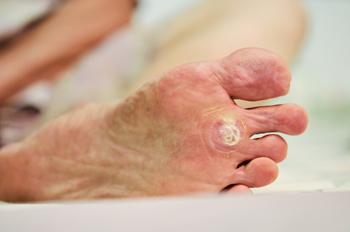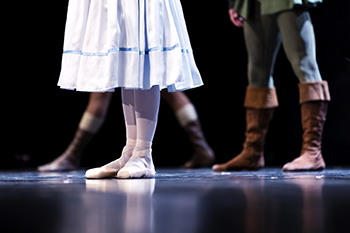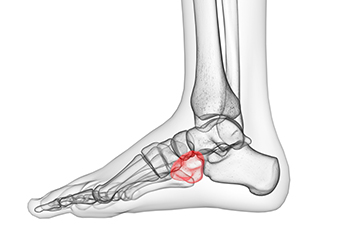
There are a variety of skin conditions that affect the feet and can be quite threatening to the vitality of your feet. Plantar warts are one such condition. These warts can develop on the bottom of the feet when an individual is exposed to a form of human papillomavirus (HPV). This generally occurs from person-to-person contact or in warm, moist environments where HPV thrives. Plantar warts can be dangerous, potentially creating holes in the soles of the feet. Some individuals with plantar warts complain that the condition is quite itchy, and some report scratching at their plantar warts. Itchy plantar warts are not unusual. This is because the plantar wart is itself made up of dry skin that is flaking, which can be itchy. There are several things that you might be able to do at home to stop your plantar warts from itching. For example, you might be able to take an oatmeal bath to soothe the affected skin area. Additionally, you can try applying moisturizer to your plantar warts to get them to stop itching. The application of moisturizer can help replenish your feet with much-needed moisture, which can help the itching subside. Please see a podiatrist to learn more about how to treat your itchy plantar warts.
Plantar warts can be very uncomfortable. If you need your feet checked, contact Brian Shwer, DPM from Southaven Foot Clinic. Our doctor will assist you with all of your foot and ankle needs.
About Plantar Warts
Plantar warts are the result of HPV, or human papillomavirus, getting into open wounds on the feet. They are mostly found on the heels or balls of the feet.
While plantar warts are generally harmless, those experiencing excessive pain or those suffering from diabetes or a compromised immune system require immediate medical care. Plantar warts are easily diagnosed, usually through scraping off a bit of rough skin or by getting a biopsy.
Symptoms
Treatment
To help prevent developing plantar warts, avoid walking barefoot over abrasive surfaces that can cause cuts or wounds for HPV to get into. Avoiding direct contact with other warts, as well as not picking or rubbing existing warts, can help prevent the further spread of plantar warts. However, if you think you have developed plantar warts, speak to your podiatrist. He or she can diagnose the warts on your feet and recommend the appropriate treatment options.
If you have any questions please feel free to contact our office located in Southaven, MS . We offer the newest diagnostic and treatment technologies for all your foot and ankle needs.

Making the decision about whether to undergo foot surgery is a difficult and highly personalized process. In consultation with a podiatrist and surgeon, you can receive the information you need to make an informed decision. Generally speaking, if you notice that a foot affliction you have is causing your skin to react negatively or your foot to become deformed, foot surgery might be a good option for you. Additionally, if you notice that your affliction is not responding to any medication your podiatrist has prescribed or any orthotics you might be wearing, then foot surgery might be a suitable last resort. There are a variety of conditions that may ultimately merit surgery. For example, particularly bad cases of Morton’s neuroma might require foot surgery. Specifically, the nerve that is affected between the toes because of Morton’s neuroma, may be successfully removed by foot surgery. Of course, foot surgery can also create detrimental consequences in some cases. There may be complications as a result of the surgery or your joint movement may be restricted. Alternatives to surgery might include performing specific exercises or adjusting footwear. You can make this difficult decision about undergoing surgery with the guidance and advice of your podiatrist.
Foot surgery is sometimes necessary to treat a foot ailment. To learn more, contact Brian Shwer, DPM of Southaven Foot Clinic. Our doctor will assist you with all of your foot and ankle needs.
When Is Surgery Necessary?
Foot and ankle surgery is generally reserved for cases in which less invasive, conservative procedures have failed to alleviate the problem. Some of the cases in which surgery may be necessary include:
What Types of Surgery Are There?
The type of surgery you receive will depend on the nature of the problem you have. Some of the possible surgeries include:
Benefits of Surgery
Although surgery is usually a last resort, it can provide more complete pain relief compared to non-surgical methods and may allow you to finally resume full activity.
Surgical techniques have also become increasingly sophisticated. Techniques like endoscopic surgery allow for smaller incisions and faster recovery times.
If you have any questions please feel free to contact our office located in Southaven, MS . We offer the newest diagnostic and treatment technologies for all your foot and ankle needs.

Although almost anyone can develop plantar fasciitis, some individuals are at a greater risk of exhibiting this foot ailment. One such higher risk group includes dancers. Plantar fasciitis is a foot condition that causes heel pain. It is caused by the inflammation of the plantar fascia that runs from the toes to the heel. Those suffering from plantar fasciitis typically experience sharp pain in the heel, tight Achilles tendons, and pronounced pain when beginning to walk after extended periods of rest. Dancers can be at a higher risk of experiencing plantar fasciitis because they engage in large amounts of physical activity wearing high heels and often exert themselves without taking adequate breaks. If dancers do not properly stretch their feet before dancing, they are more susceptible to developing plantar fasciitis. There are a number of steps that dancers can take to reduce their chances of experiencing plantar fasciitis. Namely, dancers can focus on stretching the Achilles tendon before and after dancing. Dancers might opt for the runner’s stretch, heel drops, or the downward facing dog. If you are a dancer, you might want to be proactive in protecting the health of your feet by consulting a podiatrist.
Plantar fasciitis is a common foot condition that is often caused by a strain injury. If you are experiencing heel pain or symptoms of plantar fasciitis, contact Brian Shwer, DPM from Southaven Foot Clinic. Our doctor can provide the care you need to keep you pain-free and on your feet.
What Is Plantar Fasciitis?
Plantar fasciitis is one of the most common causes of heel pain. The plantar fascia is a ligament that connects your heel to the front of your foot. When this ligament becomes inflamed, plantar fasciitis is the result. If you have plantar fasciitis you will have a stabbing pain that usually occurs with your first steps in the morning. As the day progresses and you walk around more, this pain will start to disappear, but it will return after long periods of standing or sitting.
What Causes Plantar Fasciitis?
There are some risk factors that may make you more likely to develop plantar fasciitis compared to others. The condition most commonly affects adults between the ages of 40 and 60. It also tends to affect people who are obese because the extra pounds result in extra stress being placed on the plantar fascia.
Prevention
There are a variety of treatment options available for plantar fasciitis along with the pain that accompanies it. Additionally, physical therapy is a very important component in the treatment process. It is important that you meet with your podiatrist to determine which treatment option is best for you.
If you have any questions, please feel free to contact our office located in Southaven, MS . We offer the newest diagnostic and treatment technologies for all your foot care needs.

Cuboid syndrome or cuboid subluxation is when the joints and ligaments near the cuboid bone in the foot become injured or torn. Most commonly with cuboid syndrome, pain is felt on the side of the foot where the baby toe is. The discomfort might be greater when you put weight on the side of the affected foot, when you push on the arch of the foot, or pain might spread to other parts of the foot when you stand on the front of the toes. There may be redness and swelling near the site, as well as loss of movement or weakness in the ankle or side of the foot. One might also change the way they walk (such as limping or swaying from side to side) due to the pain they feel. This syndrome may be caused when the cuboid bone moves outward from the foot while the heel bone moves inward, which may dislocate one or more bones or tear nearby ligaments. It can happen from an ankle sprain, injury, overuse or repetitive strain on the foot, or flat feet. Athletes who participate in sports involving jumping, running, or moving from side to side are prone to cuboid syndrome. This condition can also occur from being overweight, having arthritis or osteoporosis, wearing shoes that are too tight or not sufficiently supportive, not stretching the foot properly before a workout or resting it long enough before engaging in physical activity again, or doing activity on surfaces that are not flat. If you think you might have cuboid syndrome or your foot hurts for longer than what might be a normal recuperation period, see a podiatrist for a proper diagnosis and treatment.
Cuboid syndrome, also known as cuboid subluxation, occurs when the joints and ligaments near the cuboid bone in the foot become torn. If you have cuboid syndrome, consult with Brian Shwer, DPM from Southaven Foot Clinic. Our doctor will assess your condition and provide you with quality foot and ankle treatment.
Cuboid syndrome is a common cause of lateral foot pain, which is pain on the outside of the foot. The condition may happen suddenly due to an ankle sprain, or it may develop slowly overtime from repetitive tension through the bone and surrounding structures.
Causes
The most common causes of cuboid syndrome include:
Symptoms
A common symptom of cuboid syndrome is pain along the outside of the foot which can be felt in the ankle and toes. This pain may create walking difficulties and may cause those with the condition to walk with a limp.
Diagnosis
Diagnosis of cuboid syndrome is often difficult, and it is often misdiagnosed. X-rays, MRIs and CT scans often fail to properly show the cuboid subluxation. Although there isn’t a specific test used to diagnose cuboid syndrome, your podiatrist will usually check if pain is felt while pressing firmly on the cuboid bone of your foot.
Treatment
Just as the range of causes varies widely, so do treatments. Some more common treatments are ice therapy, rest, exercise, taping, and orthotics.
If you have any questions, please feel free to contact our office located in Southaven, MS . We offer the newest diagnostic and treatment technologies for all your foot care needs.